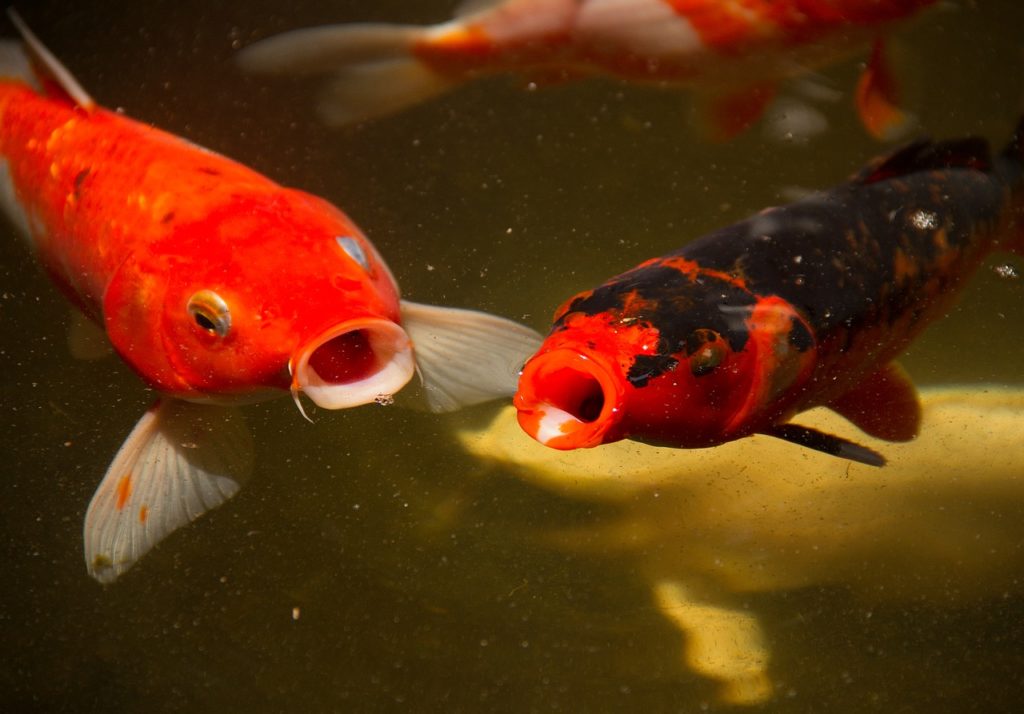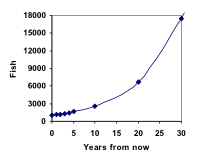Exponential Growth
Suppose that every year, only 10% of the fish in a lake have surviving offspring. If there were 100 fish in the lake last year, there would now be 110 fish. If there were 1000 fish in the lake last year, there would now be 1100 fish. Absent any inhibiting factors, populations of people and animals tend to grow by a percent of the existing population each year.

Suppose our lake began with 1000 fish, and 10% of the fish have surviving offspring each year. Since we start with 1000 fish, [latex]P_0 = 1000[/latex]. How do we calculate [latex]P_1[/latex]? The new population will be the old population, plus an additional 10%. Symbolically:
[latex]P_1 = P_0 + 0.10P_0[/latex]
Recall: representing percent as a decimal
To rewrite a percent as a decimal, drop the % symbol and move the decimal point two places to the left.
Ex.: The above statement can be read as “the number of fish in the pond after the first year is equal to the initial number of fish plus 10% of that initial number,” where 10% has been expressed in decimal form at [latex]0.10[/latex].
Notice that the previous equation could be condensed to a shorter form by factoring:
[latex]P_1 = P_0 + 0.10P_0 = 1P_0+0.10P_0 = (1+0.10) P_0 = 1.10P_0[/latex]
While 10% is the growth rate, 1.10 is the growth multiplier. Notice that 1.10 can be thought of as “the original 100% plus an additional 10%.”
For our fish population,
\[ P_1 = 1.10(1000) = 1100 \]
We could then calculate the population in later years by increasing the previous years’ population by 10%:
[latex]P_2 = 1.10P_1 = 1.10(1100) = 1210[/latex]
[latex]P_3 = 1.10P_2 = 1.10(1210) = 1331[/latex]
Plotting data for this model for the first 20 years, we see that this growth doesn’t quite appear linear.
Notice that in the first year, the population grew by 100 fish; in the second year, the population grew by 110 fish; and in the third year the population grew by 121 fish. This model is not linear because the amount of fish added changes each year. While there is a constant percentage growth, the actual increase in number of fish is increasing each year.
Like with linear growth, if we can find an explicit formula for exponential growth, we will be able to quickly calculate values further out in the future. Let’s see if we can find a pattern in our calculations. Recall that the initial population of fish, [latex]P_0[/latex], is 1000 and to find [latex]P_1[/latex] (the population after 1 year) we multiply [latex]P_0 \text{ by } 1.10[/latex], the growth multiplier. That is,
\[P_0=1000,\]
\[P_1=1.10\cdot P_0=1.10\cdot1000.\]
To find the population of fish in each subsequent year, we multiply the previous year’s population by 1.10 (which equals 1.1).
\[P_2 = 1.1 \cdot P_1 = 1.1 \cdot 1.1 \cdot 1000 = 1.1^2 \cdot 1000\]
\[ P_3 = 1.1 \cdot P_2 = 1.1 \cdot 1.1 \cdot 1.1 \cdot 1000 = 1.1^3 \cdot 1000\]
\[ P_4 = 1.1 \cdot P_2 = 1.1 \cdot 1.1 \cdot 1.1 \cdot 1.1 \cdot 1000 = 1.1^4 \cdot 1000\]
Observing a pattern, we can generalize the explicit formula to be:
\[P_n =1.1^n \cdot 1000, \text{ or equivalently, } P_n = 1000 \cdot 1.1^n.\]
[Notice that this formula also works for [latex]P_0 \text{ since } 1.1^0\cdot1000=1\cdot1000=1000[/latex].]
From this explicit formula, we can quickly calculate the number of fish in 10, 20, or 30 years:

\[P_{10} = 1000 (1.1^{10}) = 2594\]
\[P_{20} = 1000 (1.1^{20}) = 6727\]
\[P_{30} = 1000 (1.1^{30}) = 17449\]
Adding these values to our graph reveals a shape that is definitely not linear. If our fish population had been growing linearly, by 100 fish each year, the population would have only reached 4000 in 30 years, compared to almost 18,000 with this percent-based growth, called exponential growth. With exponential growth, the population grows proportional to the size of the population, so as the population gets larger, the same percent growth will yield a larger numeric growth.
Exponential Growth
If a quantity starts at size [latex]P_0[/latex] and grows by R% (written as a decimal, [latex]r[/latex]) every time period, then the quantity after [latex]n[/latex] time periods can be determined by using the following formula:
[latex]P_n = P_0 \left( 1+r \right)^n[/latex]
We call [latex]r[/latex] the growth rate and the number [latex](1+r)[/latex] is called the growth multiplier, or common ratio.
Example
Between 2007 and 2008, Olympia, WA grew almost 3% to a population of 245 thousand people. If this growth rate was to continue, what would the population of Olympia be in 2014?
This example is also worked out in the following video.
Evaluating exponents on the calculator
To evaluate expressions like (1.03)6, it will be easier to use a calculator than multiply 1.03 by itself six times. Most scientific calculators have a button for exponents. The exponent key on a calculator is typically labeled in one of the following ways:
^ , [latex]y^x, \text{ or } x^y.[/latex]
To evaluate 1.036 on a calculator, we’d type 1.03 ^ 6, [latex]1.03 y^x 6, \text{ or } 1.03 x^y 6[/latex]. Try it out – you should get an answer around 1.1940523.
Try It
Example
A friend is using the equation Pn = 4600(1.072)n to predict the annual tuition at a local college where n is the number of years after 2010. What does this equation tell us?
View the following to see this example worked out.
Recall: Some Useful tips
Rounding with Exponential Growth
A very small difference in the growth rates gets magnified greatly in exponential growth. For this reason, it is recommended to round the growth rate as little as possible.
If you need to round, keep at least three significant digits – numbers after any leading zeros.
Parentheses and Calculators
Pay careful attention to your use of parentheses. They are often necessary to force the desired order of operations when using your calculator. For example, typing [latex]8y^x1/3[/latex] or 8^1/3 into your calculator would tell the calculator to first raise 8 to the power of 1, then divide the result by 3, giving a final answer of 8/3. However, typing [latex]8y^x(1/3)[/latex] or 8^(1/3) into your calculator would tell the calculator to raise 8 to the power of 1/3, giving a final answer of 2.
We have now studied two very different growth models. So how do we know which growth model to use when working with data? There are two approaches which should be used together whenever possible:
- Find more than two pieces of data (at least 5, when possible). Plot the values, and look at the graph for a trend. Does the data appear to be changing like a line, or do the values appear to be curving more steeply upwards?
- Consider the factors contributing to the data. Are they things you would expect to change linearly or exponentially? For example, in the case of fish population, we could expect that, absent other factors, it would be tied closely to how big the current population is and therefore would grow exponentially.
Candela Citations
- Revision and Adaptation. Provided by: Lumen Learning. License: CC BY: Attribution
- Exponential (Geometric) Growth. Authored by: David Lippman. Located at: http://www.opentextbookstore.com/mathinsociety/. Project: Math in Society. License: CC BY-SA: Attribution-ShareAlike
- calf-fish-lake-pond-river. Authored by: Pexels. Located at: https://pixabay.com/en/calf-fish-lake-pond-river-1869984/. License: CC0: No Rights Reserved
- Exponential Growth Model Part 1. Authored by: OCLPhase2's channel. Located at: https://youtu.be/3BiU7Ihxvxg. License: CC BY: Attribution
- Exponential Growth Model Part 2. Authored by: OCLPhase2's channel. Located at: https://youtu.be/tg2ysaZ8agY. License: CC BY: Attribution
- Predicting future population using an exponential model. Authored by: OCLPhase2's channel. Located at: https://youtu.be/CDI4xS65rxY. License: CC BY: Attribution
- Interpreting an Exponential Equation. Authored by: OCLPhase2's channel. Located at: https://youtu.be/T8Yz94De5UM. License: CC BY: Attribution
- Finding an Exponential Model. Authored by: OCLPhase2's channel. Located at: https://youtu.be/9Zu2uONfLkQ. License: CC BY: Attribution
- Comparing exponential to linear growth. Authored by: OCLPhase2's channel. Located at: https://youtu.be/yiuZoiRMtYM. License: CC BY: Attribution
- Question ID 6598. Authored by: Lippman, David. License: CC BY: Attribution. License Terms: IMathAS Community License CC-BY + GPL


